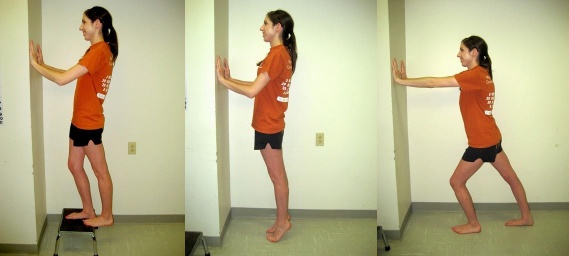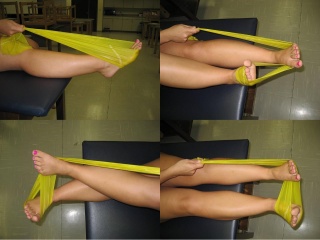Syndesmotic Ankle Sprains: Difference between revisions
No edit summary |
No edit summary |
||
| Line 43: | Line 43: | ||
*'''<u>Special Test</u>:''' | *'''<u>Special Test</u>:''' | ||
<br>'''[[Image:ER of the foot.JPG|thumb|left]]1. External Rotation''' '''Test''' (Kleiger’s Test) (Starkey)<br> | <br>'''[[Image:ER of the foot.JPG|thumb|left|ER of the foot.JPG]]1. External Rotation''' '''Test''' (Kleiger’s Test) (Starkey)<br> | ||
- Determines rotator damage to the deltoid ligament or the distal tibiofibular syndesmosis. | - Determines rotator damage to the deltoid ligament or the distal tibiofibular syndesmosis. | ||
| Line 53: | Line 53: | ||
<br> | <br> | ||
[[Image:Squeeze Test.JPG|thumb|right]]<br> | [[Image:Squeeze Test.JPG|thumb|right|Squeeze Test.JPG]]<br> | ||
'''2. [http://www.physio-pedia.com/index.php5?title=Squeeze_Test Squeeze Test]'''- separation of the tibia and fibula (Evaluation Handbook)<br>- Identifies a fibular fracture or syndesmosis sprain. | '''2. [http://www.physio-pedia.com/index.php5?title=Squeeze_Test Squeeze Test]'''- separation of the tibia and fibula (Evaluation Handbook)<br>- Identifies a fibular fracture or syndesmosis sprain. | ||
Revision as of 22:21, 17 July 2011
Original Editors
Lead Editors - Your name will be added here if you are a lead editor on this page. Read more.
Search Strategy[edit | edit source]
add text here related to databases searched, keywords, and search timeline
Definition/Description[edit | edit source]
A syndesmotic, or ‘high’ ankle sprain is one that involves the ligaments binding the distal tibia and fibula. Injuries can occur with any ankle motion, but the most common motions are extreme external rotation or dorsiflexion of the Talus. The dome of the Talus is wider in the anterior than in the posterior, and these movements force apart the medial and lateral aspects of the mortise, respectively the tibial and fibular malleoli. Sufficient distraction of the distal fibula from the tibia can cause strain or rupture of one or more of the following ligaments: the anterior tibiofibular ligament, superficial posterior inferior tibiofibular ligament, transverse tibiofibular ligament. (Norkus) Rupture injuries also commonly present with concomitant fractures of the either malleolus (lateral being more common) or proximal fibular spiral fracture known as a Maissonneuve fracture. (Clanton ’03)
Epidemiology/Etiology[edit | edit source]
Syndesmotic ankle sprains commonly occur to athletes participating in American football and downhill skiing. Football injuries are usually a result of forced external rotation of the foot while the athlete is prone, as in at the bottom of the pile. The injuries can also result from a blow to the lateral knee while the foot is planted and dorsiflexed, resulting in an eversion or external rotation moment at the talocrural joint.
In downhill ski racing, the boot does not allow dorsi- or plantar-flexion movement, which can result in excessive allowance of talocrural external rotation and injury to the anterior or posterior tibiofibular ligament, as well as the interosseous membrane.
Research has documented that syndesmosis injuries account for 1-11% of all injuries (Norkus). Incidence among professional American football players is reported to be much high, up to 29% as documented by Boytim et al (91)
Characteristics/Clinical Presentation[edit | edit source]
Observationally the Syndesmotic will show significantly less swelling than a lateral ankle sprain, as well as demonstrate a loss of full plantar flexion and an inability to bear weight2. Ecchymosis may appear several days post-injury due to the injury of the intereosseuos membrane. A difficulty or inability to toe walk are often noted. History includes chronic pain, prolonged recovery, recurrent sprains, and the formation of heterotopic ossification within the interosseous membrane( Prospective Evaluation of SyndesmoticAnkle Sprains Without Diastasis*) The most common MOI is when the foot is in external rotation with excessive dorsiflexion(JOSPT Ankle syndesmosis injuries: anatomy, biomechanics, mechanism of injury, and clinical guidelines for diagnosis and intervention. 2006 Jun;36(6):372-84.
Differential Diagnosis[edit | edit source]
Because of the occult nature of the high ankle sprain during clinical evaluation it is important to rule out pathologies with a similar MOI. First and foremost an x-ray should be taken to rule out fx of the tibia, fibula and/or the talus (Clinical Review, Norwig). Secondly, the clinician should address concerns of a lateral ankle sprain as the mechanism of injury are between the two injuries are very similar. Norwig writes “Syndesmotic ankle sprains can usually be distinguished from inversion ankle sprains by a history of an external rotation component.” Other possible pathologies are medial ankle sprain, compartment syndrome, severe joint laxity, severe contusion, dystrophic calcification, infection or tumor. These pathologies should be preferentially ruled out before tx of a syndesmotic ankle sprain begins.
Outcome Measures[edit | edit source]
Examination[edit | edit source]
Hx and MOI: see clinical presentation
- Observation/Gait analysis: Check for discrepancies
- Palpation:tenderness proximally over the anterior tibiofibular ligament and proximal along the interosseous membrane (Fincher)
- Palpate the medial and lateral malleoli for exidence of a fracture (Dressendorfer)
- Fibula needs to be palpated from distal to proximal, including the proximal tibiofibular joint to rule out Maissoneuve’s fracture . (Clayton)
- Distal Pulses: Ensure pedal pulses are present (Dressendorfer)
- Girth Measurements: Notable swelling of ankle do Figure 8 girth measurements (Andrews et. el)
- Special Test:
1. External Rotation Test (Kleiger’s Test) (Starkey)
- Determines rotator damage to the deltoid ligament or the distal tibiofibular syndesmosis.
- Performed by having the knee flexed by 90 degrees with the ankle in neutral position and appyling an external rotational force to the affected foot and ankle. (Recognizing and rehabilitation the high ankle sprain)
-(+) test: Pain in the anterolateral ankle. An indicator of deltoid ligament damage would be if there is a displacement of the talus away from the medial malleolus.
- Interrater kappa= 0.75 (best)- (Alonso); (Clanton)
2. Squeeze Test- separation of the tibia and fibula (Evaluation Handbook)
- Identifies a fibular fracture or syndesmosis sprain.
- Performed by squeezing the tibia and fibula together above the injury.
-(+) test: Pain will be reproduced along the fibular shaft if it’s a fibular fracture and the distal tibiofibular jt for syndesmosis sprain.
- interrater= 0.5 (moderate). (Alonso)
3. Cotton Test (Magee)
- Assess for syndesmosis instability with diastasis.
- Performed: steadying the distal leg with one hand while grasping the plantar hell with the opposite hand and moving the heel directly from side to side (Clanton)
- (+) test: Any lateral translation would indicate syndesmotic instability (Magee)
Medical Management
[edit | edit source]
Imaging is still considered the diagnostic standard and should be sought as quickly as possible to rule out any expected fractures and to aid in restoring normal anatomy. A one MM lateral displacement of the fibula, results in a reduction in the available of area of tibiotalar contact in weight bearing by 42%4! One can easily see how such a “minor” yet misdiagnosed injury can lead to a lifetime of chronic sprains. Plain films are the bare minimum suggested, but due to the complexity of the structures and tissues, a CT scan is recommended for bony detail, MRIs give an accurate picture of the ligamentous injury, and they are the imaging gold standard for this injury. They are surpassed in accuracy only by arthroscopy 2. Images should be done in a bilateral fashion to better determine an injury from a natural joint gap or overlap.
Physical Therapy Management
[edit | edit source]
1.) Calf Stretch with Step 2.) Calf Strengthening Exercise 3.) Lunging Calf Stretch
Goals:
- First two weeks: ROM, decrease pain and swelling, protect ligaments against further injury (Harvard)
- Week 3 and onward: Restore normal ROM, strengthen ligaments and supporting muscles, training to improve endurance and balance (Harvard)
- Most important long-term goal is to prevent re-injury! (Bleakley)
Patient Education:
- Surgeon/PT’s recommended weightbearing protocol (clinical review)
- Caution against vigorous physical activity until full weight bearing and dynamic balance has normalized. (clinical review)
- Gait training with crutches or boot/brace (clanton)
- Fall risk (clinical review)
Assistive Devices:
- Crutches- must be maintained until normal, pain free gait is obtained (Fincher)
- Walking boot or stirrup brace for unstable injuries (Clanton)
Modalities:
- RICE (rest, ice, compression, elevation) initially for 15 min 3x a day. (Harvard). However, Bleakley et al suggested that there is little evidence to support the use of RICE, although it is a widely accepted treatment (Dolan)
- Non-steroidal anti-inflammatory drugs and comfrey ointment have been shown to improve short-term recovery following acute ankle sprain. (Dolan)
Therapeutic Exercise/ Neuromuscular Re-education:
- First two weeks: AROM flexion, ankle alphabet, dorsiflexion/plantarflexion and inversion/eversion with theraband (Harvard)
- Weeks 3-4: Standing Stretch, seated dorsiflexion stretch with theraband, double heel raise progressing to single heel raise, and dorsiflexion stretching on step stool (Harvard)
- Progressive weightbearing and treadmill gait training to promote normal gait pattern. (Fincher, Clinical Review)
- Neuromuscular Re-education: ankle proprioception, postural reflexes and balance
Ex: Single-leg stance, disk or balance pad training, aquatic therapy
- Progress to jogging, cycling, agility, jumping, and sport-specific drills. (clinical review)
- Modify exercises to avoid hyperdorsiflexion (stresses mortise joint)(Fincher), subtalar eversion, and loaded external rotation. (Fincher)
Manual Therapy:
- Passive accessory movement of the talocrural and subtalar joints and passive stretching may help stiffness. (Clinical Review)
- Green et al: those subjects who used RICE with manual therapy were more likely to reach this normal ROM within the first 2 weeks of the ankle sprain than those who received RICE alone. (Green)
- Collins et al: Subjects showed immediate ROM gains when Mulligan’s movement with mobilization was applied in the sub-acute sprains after ankle sprains and in patients with recurrent sprains. (Collins)
- Landrum et al: Reported that one 30-second A-P talocrural joint mob immediately increased ankle dorsiflexion ROM after prolonged mobilization. (Landrum)
**The recovery for Syndesmotic Ankle Sprain is often twice that of a typical ankle sprain!**
1.) Theraband Plantarflexion 2.) Theraband Dorsiflexion
3.) Theraband Inversion 4.) Theraband Eversion
Key Research[edit | edit source]
add links and reviews of high quality evidence here (case studies should be added on new pages using the case study template)
Resources
[edit | edit source]
add appropriate resources here
Clinical Bottom Line[edit | edit source]
add text here
Recent Related Research (from Pubmed)[edit | edit source]
see tutorial on Adding PubMed Feed
Extension:RSS -- Error: Not a valid URL: Feed goes here!!|charset=UTF-8|short|max=10
References[edit | edit source]
see adding references tutorial.
Norkus S, Floyd RT, The Anatomy and Mechanisms of Synedesmotic Ankle Sprains. J Athletic Training. 2001;36:68-73
Boytim MJ, Fischer DA, Neumann L. Syndesmotic ankle sprains. Am J Sports Med. 1991;19:294–298.








